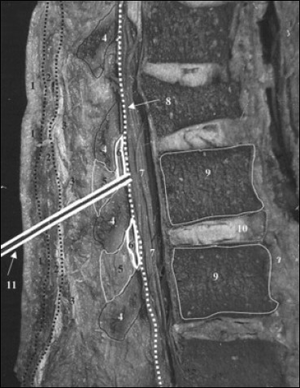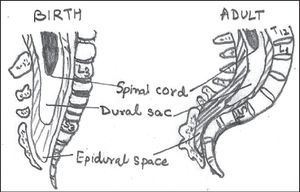We need you! Join our contributor community and become a WikEM editor through our open and transparent promotion process.
Lumbar puncture
From WikEM
(Redirected from CSF Results)
Contents
Indications
- Suspicion of meningitis [1]
- Suspicion of subarachnoid hemorrhage (SAH) [2]
- Suspicion of certain central nervous system (CNS) diseases such as Guillain-Barré syndrome [3]
- Therapeutic relief of pseudotumor cerebri [4]
Contraindications
- Infection at LP site
- Suspected spinal epidural abscess
Lumbar puncture if coagulopathic
- Tranfuse if platelets <25,000[5][6]
- INR >1.5
- Hemophilia, von Willebrand disease, other coagulopathies
- If hemophiliac, replace factor before LP
CT Before Lumbar Puncture
LP without CT is likely safe if:[7]
- History
- Age < 60
- Not immunocompromised
- No history of CNS disease
- No seizure within 1 week of presentation
- Physical Exam
- No ALOC
- Ability to answer two consecutive questions successfully
- Ability to follow two consecutive commands successfully
- Normal neurologic exam
- No ALOC
If none of the above, chance of normal ct is 97%; none of the patients herniated
CT findings that prohibit LP:[8]
- Midline shift
- Unequal pressures between the 3 cerebral compartments (left/right supretentorial compartments, posterior fossa)
- Intracerebral masses not causing midline shift
- Obstructive Hydrocephalus
- Enlargement of ventricles prox to lesions and normal ventricles distal (especially 4th ventricle)
- Basilar cisterns compressed
- Lateral/3rd ventricles may be small due to diffuse cerebral edema or enlarged due to obstr. hydroceph. +/- shift
- Posterior fossa mass
- Displacement/compression of 4th ventricle
Procedure
- Sterile prep L3-L4 and L4-L5 interspaces; prepare and confirm correct tubes in numerical order
- Positioning
- Patient on side: able to measure opening pressure
- Patient sitting: helpful for difficult habitus, but must move patient to measure opening pressure
- Needle selection
- 3.5 in atraumatic 22ga needle is ideal
- Needle >20ga almost doubles incidence of post-LP headache
- Anesthetize both superficial skin as well as along intended path of LP needle
- Insert needle with bevel parallel to spinal canal
- Opening pressure should be measured with patient on side with legs extended
- Collect 1mL of CSF in each tube
CSF Studies
Standard
- Tube 1: Gram Stain and culture
- Tube 2: Protein and glucose
- Tube 3: Cell count w diff
- Tube 4: Hold
Additional
- Cryptoccal ag
- India ink
- AFB PCR
- RPR, VRDL
- Fungal cultures
- viral cultures
- Herpes PCR
- LDH
- >40 suggests bacterial meningitis
- <40 suggests viral
Evaluation
| Measure | Normal | Bacterial | Aseptic (Viral) | Fungal | Tuberculosis | Subarachnoid hemorrhage | Neoplastic |
| Appearance | Clear | Clear, cloudy, or purulent | Clear | Clear or opaque | Clear or opaque | Xanthochromia, bloody, or clear | Clear or opaque |
| Opening Pressure (cm H2O) | 10-20 | >25 | Normal or elevated | >25 | >25 | >25 | Normal or elevated |
| WBC Count^ (cells/µL) | 0-5^ | >100^ | 5-1000 | <500 | 50-500 | 0-5 (see correction section) | <500 |
| % PMNs | >80-90% | 1-50%^^ | 1-50% | Early PMN then lymph | 1-50% | ||
| Glucose | >60% of serum glucose | Low | Normal | Low | Low | Normal | Normal |
| Protein^^^ (mg/dL) | < 45 | Elevated | Elevated | Elevated | Elevated | Elevated | >200 |
| Gram Stain | Neg | Pos | Neg | India ink | Tb stain | Blood |
- ^Normal or lower WBC results may be found in immunocompromised, early, or partially treated (e.g. with oral antibiotics) bacterial menintigis, and those with tuberculosis meningitis
- ^^Lymph predominance may be found in patients with early bacterial meningitis or those that have been partially treated (e.g. with oral antibiotics)
- ^^^For unexplained elevations of protein, consider encephalitis, MS, Guillian Barre
Corrections
- WBC correction (for bloody tap)
- Simplified version (if peripheral WBC and RBC counts are within normal limits):
- Subtract 1 WBC for every 750 RBC in CSF
- Complex version (WBC and/or RBC not within normal limits):
- "WBCs added" = WBC(blood) x [RBC(CSF) / RBC(blood)]
- WBC counted/resulted - "WBCs added" = actual WBC
- Simplified version (if peripheral WBC and RBC counts are within normal limits):
- Protein correction (for bloody tap)
- For each 1000 RBC decrease protein value by 1mg/dl
Delay in LP
- CSF cultures are negative 2 hrs after parenteral antibiotics in meningococcal meningitis, and 6 hrs in pneumococcal meningitis[11][12]
- 12 hrs after antibiotics: CSF glucose levels increase and protein levels decrease. CSF WBC and neutrophils are not affected[13]
Complications
External Links
See Also
References
- ↑ CDC: Meningitis
- ↑ Carley, S. Harrison, M. Timing of lumbar puncture in suspected subarachnoid haemorrhage. Emerg Med J 2005;22:121-122
- ↑ Petzold A, Brettschneider J, Jin K, et al. CSF protein biomarkers for proximal axonal damage improve prognostic accuracy in the acute phase of Guillain-Barré syndrome. Muscle Nerve. 2009 Jul. 40(1):42-9
- ↑ Chern JJ, Tubbs RS, Gordon AS, Donnithorne KJ, Oakes WJ. Management of pediatric patients with pseudotumor cerebri. Childs Nerv Syst. 2012 Jan 19
- ↑ Howard SC, Gajjar A, Ribeiro RC, et al. Safety of lumbar puncture for children with acute lymphoblastic leukemia and thrombocytopenia. JAMA 2000; 284:2222–2224
- ↑ Vavricka SR, Walter RB, Irani S, Halter J, Schanz U. Safety of lumbar puncture for adults with acute leukemia and restrictive prophylactic platelet transfusion. Ann Hematol 2003; 82:570–573
- ↑ *NEJM 2001; 345; 1727-33
- ↑ Emergency Radiology: Case Studies Schwartz
- ↑ Nomura, J, et al. A randomized control study of ultrasound-assisted lumbar puncture. J Ultrasound Med. 2007; 26:1341–8.
- ↑ Gupta A and Usha U. Spinal anesthesia in children: A review. J Anaesthesiol Clin Pharmacol. 2014 Jan-Mar; 30(1): 10–18.
- ↑ Kanegaye JT, Soliemanzadeh P, Bradley JS. Lumbar puncture in pediatric bacterial meningitis: defining the time interval for recovery of cerebrospinal fluid pathogens after parenteral antibotic pretreatment. Pediatrics2001;108:1169–74
- ↑ Michael B1, Menezes BF, Cunniffe J, Miller A, Kneen R, Francis G, Beeching NJ, Solomon T. Effect of delayed lumbar punctures on the diagnosis of acute bacterial meningitis in adults. Emerg Med J 2010;27:6 433-438. PMID 20360497
- ↑ Lise E. Nigrovic, Richard Malley, Charles G. Macias, John T. Kanegaye, Donna M. Moro-Sutherland, Robert D. Schremmer, Sandra H. Schwab, Dewesh Agrawal, Karim M. Mansour, Jonathan E. Bennett, Yiannis L. Katsogridakis, Michael M. Mohseni, Blake Bulloch, Dale W. Steele, Ron L. Kaplan, Martin I. Herman, Subhankar Bandyopadhyay, Peter Dayan, Uyen T. Truong, Vince J. Wang, Bema K. Bonsu, Jennifer L. Chapman, Nathan Kuppermann. Effect of Antibiotic Pretreatment on Cerebrospinal Fluid Profiles of Children With Bacterial Meningitis. Pediatrics Oct 2008, 122 (4) 726-730. PMID 18829794




